NCERT Solutions for Class 9 Maths Chapter 9 Areas of Parallelograms and Triangles – This article contains detailed Solutions for NCERT Class 9 Maths Chapter 9 Areas of Parallelograms and Triangles curated by the team of subject matter experts at GFG, to help students understand how to solve the NCERT problems in an easy manner.
NCERT Class 9 Maths Chapter 9 Areas of Parallelograms and Triangles covers all the following topics:
This article provides solutions to all the problems asked in Class 9 Maths Chapter 7 Triangles of your NCERT textbook in a step-by-step manner. Solutions to all the exercises in the NCERT Class 9 Maths Chapter 7 Triangles are regularly revised to check errors and updated according to the latest CBSE Syllabus 2023-24 and guidelines.
All of the problems in Chapter 9 Areas of Parallelograms and Triangles exercises from the NCERT textbook have been covered in the NCERT Solutions for Class 9 Maths.
NCERT Solutions Class 9 Maths Chapter 9 Areas of Parallelograms and Triangles: Exercise 9.1
Question 1: Which of the following figures lie on the same base and in between the same parallels? In such a case, write the common base and the two parallels.

Solution:
(i) Since, ABCD is a Trapezium and ΔPDC lie on the same base of Trapezium i.e DC and ΔPDC lie in-between the same parallel lines AB and DC.

(ii) Since, Parallelogram PQRS and trapezium SMNR lie on the same base SR but not in-between the same parallel lines.

(iii) Since, Parallelogram PQRS and ΔRTQ lie on the same base QR and ΔRTQ lie in-between the same parallel lines QR and PS.

(iv) Since, Parallelogram ABCD and ΔPQR do not lie on the same base but ΔPQR lie in-between the same parallel lines BC and AD.

(v) Since, Quadrilateral ABQD and trapezium APCD lie on the same base AD and in-between the same parallel lines AD and BQ.

(vi) Since, Parallelogram PQRS and parallelogram ABCD do not lie on the same base SR but parallelogram ABCD in-between the same parallel lines SR and PQ.

NCERT Solutions for Class 9 Maths Chapter 9 Areas of Parallelograms and Triangles: Exercise 9.2
Question 1: In given Fig. ABCD is a parallelogram, AE ⊥ DC and CF ⊥ AD. If AB = 16 cm, AE = 8 cm and CF = 10 cm, find AD?

Solution:
As Given in the Question,
AB = CD = 16 cm (Opposite sides of a parallelogram)
CF = 10 cm and AE = 8 cm
Now, As we have studied in this Chapter we know,
Area of Parallelogram = Base x Altitude
⇒ CD × AE = AD × CF
⇒ 16 × 8 = AD × 10
⇒ AD = 128/10 cm
⇒ AD = 12.8 cm
Question 2: If E, F, G, and H are respectively the mid-points of the sides of a parallelogram ABCD, show that ar (EFGH) = 1/2 ar(ABCD)?
Solution:

As Given in the Question ,
E, F, G and H are the mid-points of the sides of a parallelogram ABCD respectively.
To Prove,
ar (EFGH) = ½ ar(ABCD)
First, we have to do some construction
join H to E
Proof:
As we know,
AD || BC and AD = BC (Opposite sides of a parallelogram)
⇒ ½ AD = ½ BC
As H and F are the mid points of AD and BC
AH || BF and and DH || CF
Therefore,
AH = BF and DH = CF (H and F are mid points)
∴ ABFH and HFCD are parallelograms.
As we know that, ΔEFH and parallelogram ABFH, both lie on the same base FH and ΔEFH lie in-between the same parallel lines AB and HF.
Therefore,
Area of EFH = ½ Area of ABFH — (i)
And, Area of GHF = ½ Area of HFCD — (ii)
Now, Adding (i) and (ii) we get,
Area of ΔEFH + Area of ΔGHF = ½ Area of ABFH + ½ Area of HFCD
⇒ Area of EFGH = Area of ABFH
∴ ar (EFGH) = ½ ar(ABCD)
Question 3: P and Q are any two points lying on the sides DC and AD respectively of a parallelogram ABCD. Show that ar(APB) = ar(BQC)?
Solution:

ΔAPB and parallelogram ABCD lie on the same base AB and ΔAPB lie in-between same parallel AB and DC.
Now, As we know that
ar(ΔAPB) = ½ ar(parallelogram ABCD) — (i)
Similarly,
ar(ΔBQC) = ½ ar(parallelogram ABCD) — (ii)
From (i) and (ii), we have
ar(ΔAPB) = ar(ΔBQC)
Hence proved,
Question 4: In the Figure, P is a point in the interior of a parallelogram ABCD. Show that
(i) ar(APB) + ar(PCD) = ½ ar(ABCD)
(ii) ar(APD) + ar(PBC) = ar(APB) + ar(PCD)
[Hint : Through P, draw a line parallel to AB.]

Solution:
Given: P is a point in the interior of the parallelogram ABCD
To prove: Area(APB) + Area(PCD) = ½ Area(ABCD)
Construction:
Through P, draw a line EF parallel to AB

Proof:
(i) In a parallelogram,
AB || EF (by construction) — (i)
∴AD || BC ⇒ AE || BF — (ii)
From equations (i) and (ii),
ABFE is a parallelogram.
Now,
ΔAPB and parallelogram ABFE are lying on the same base AB and ΔAPB lie in-between the same parallel lines AB and EF.
∴ ar(ΔAPB) = ½ ar(ABFE) — (iii)
also,
ΔPCD and parallelogram CDEF are lying on the same base CD and ΔPCD lie in-between the same parallel lines CD and EF.
∴ ar(ΔPCD) = ½ ar(CDEF) — (iv)
Adding equations (iii) and (iv) we get,
ar(ΔAPB) + ar(ΔPCD) = ½ [ar(ABFE)+ar(CDEF)]
⇒ ar(APB)+ ar(PCD) = ½ ar(ABCD)
Hence Proved
(ii) Construction:
Through P, draw a line GH parallel to AB

In the parallelogram,
AD || GH (by construction) — (i)
∴AB || CD ⇒ AG || DH — (ii)
From equations (i) and (ii) we get,
AGDH is a parallelogram.
Now,
ΔAPD and parallelogram AGHD are lying on the same base AD and ΔAPD lie in-between the same parallel lines AD and GH.
∴ar(ΔAPD) = ½ ar(AGHD) — (iii)
also,
ΔPBC and parallelogram BCHG are lying on the same base BC and ΔPBC lie in-between the same parallel lines BC and GH.
∴ar(ΔPBC) = ½ ar(BCHG) — (iv)
Adding equations (iii) and (iv) we get,
ar(ΔAPD) + ar(ΔPBC) = ½ {ar(AGHD) + ar(BCHG)}
⇒ ar(APD) + ar(PBC) = ar(APB) + ar(PCD)
Hence Proved
Question 5: In the Figure, PQRS and ABRS are parallelograms and X is any point on side BR. Show that:
(i) ar (PQRS) = ar (ABRS)
(ii) ar (AXS) = ½ ar (PQRS)

Solution:
Given: PQRS and ABRS are parallelograms and X is any point on side BR
To Prove: (i) ar (PQRS) = ar (ABRS)
(ii) ar (AXS) = ½ ar (PQRS)
Proof:
(i) In ΔPSA and ΔQRB,
∠ SPA = ∠ RQB — (i) (Corresponding Angles from PS || QR and traversal PB
∠ PAS = ∠ QBR — (ii) (Corresponding Angles from AS || BR and traversal PB
∠ PSA = ∠ QRB — (iii) (Angle Sum Property of triangle)
Also, PS = QR — (iv) (Opposite sides of Parallelogram PQRS)
In view of (i), (iii) and (iv),
ΔPSA ≅ ΔQRB — (v) (By ASA Rule)
∴ Area(ΔPSA) = Area(ΔQRB) — (vi)
∴ Congruent figures have Equal Area
Now, ar(PQRS) = Area(ΔPSA) + Area(AQRS)
= Area(ΔQRB) + Area(AQRS) —–|| Using (vi)
= ar(ABRS)
∴ar (PQRS) = ar (ABRS)
Hence Proved
(ii) ΔAXS and Parallelogram ABRS are on the Same base As and between the Same parallels AS and BR
∴ Area(ΔAXS) = ½ Area(Parallelogram ABRS)
= ½ {Area(AQRS) + Area(ΔQRB)}
= ½ Area(Parallelogram PQRS)
Hence Proved
Question 6: A farmer was having a field in the form of a parallelogram PQRS. She took any point A on RS and joined it to points P and Q. In how many parts the fields are divided? What are the shapes of these parts? The farmer wants to sow wheat and pulses in equal portions of the field separately. How should she do it?
Solution:

The field is divided into three parts each in triangular shape.
Let, ΔPSA, ΔPAQ and ΔQAR be the triangles.
Area of (ΔPSA + ΔPAQ + ΔQAR) = Area of PQRS — (i)
Area of ΔPAQ = ½ area of PQRS — (ii)
Here, the triangle and parallelogram are on the same base and in-between the same parallel lines.
From (i) and (ii) we get,
Area of ΔPSA + Area of ΔQAR = ½ area of PQRS — (iii)
From (ii) and (iii), we can conclude that,
The farmer must sow wheat or pulses in ΔPAQ or either in both ΔPSA and ΔQAR.
NCERT Solutions Class 9 Maths Chapter 9 Areas of Parallelograms and Triangles: Exercise 9.3
Question 1. In Figure, E is any point on median AD of a ΔABC. Show that ar (ABE) = ar(ACE).
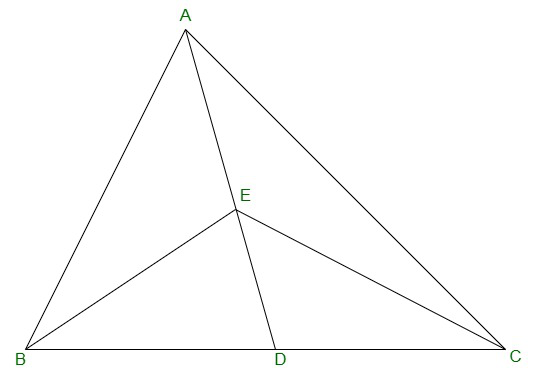
Solution:
Given:
AD is median of ΔABC.
Therefore,
It will divide ΔABC into two triangles of equal area.
Therefore,
ar(ABD) = ar(ACD) -(equation 1)
also,
ED is the median of ΔABC.
Therefore,
ar(EBD) = ar(ECD) -(equation 2)
Subtracting equation (2) from (1),
ar(ABD) – ar(EBD) = ar(ACD) – ar(ECD)
=> ar(ABE) = ar(ACE)
Question 2. In a triangle ABC, E is the mid-point of median AD. Show that ar(BED) = 1/4 ar(ABC).
Solution:
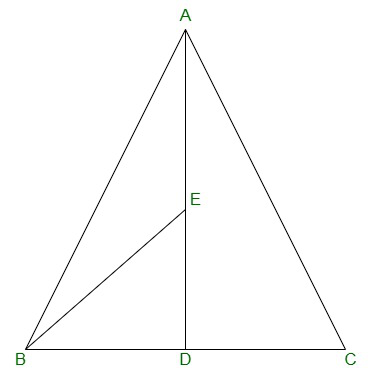
ar(BED) = (1/2)×BD×DE
Thus,
E is the mid-point of AD,
AE = DE
Thus,
AD is the median on side BC of triangle ABC,
BD = DC
DE = (1/2) AD -(equation 1)
BD = (1/2)BC -(equation-2)
From equation (1) and (2), we get,
ar(BED) = (1/2) × (1/2)BC × (1/2)AD
=> ar(BED) = (1/2) × (1/2)ar(ABC)
=> ar(BED) = 1/4 ar(ABC)
Question 3. Show that the diagonals of a parallelogram divide it into four triangles of equal area.
Solution:
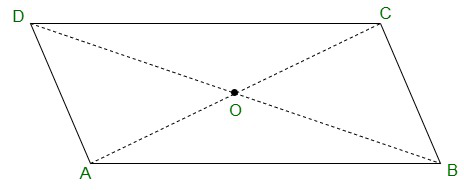
O is the mid point of AC and BD. (as diagonals bisect each other)
In ΔABC, BO is the median.
Therefore,
ar(AOB) = ar(BOC) -(equation 1)
also,
In ΔBCD, CO is the median.
Therefore,
ar(BOC) = ar(COD) -(equation 2)
In ΔACD, OD is the median.
Therefore,
ar(AOD) = ar(COD) -(equation 3)
In ΔABD, AO is the median.
Therefore,
ar(AOD) = ar(AOB). -(equation4)
From equations (1), (2), (3) and (4), we have,
ar(BOC) = ar(COD) = ar(AOD) = ar(AOB)
Therefore,
we get, the diagonals of a parallelogram divide it into four triangles of equal area.
Question 4. In Figure, ABC and ABD are two triangles on the same base AB. If line- segment CD is bisected by AB at O, show that: ar(ABC) = ar(ABD).
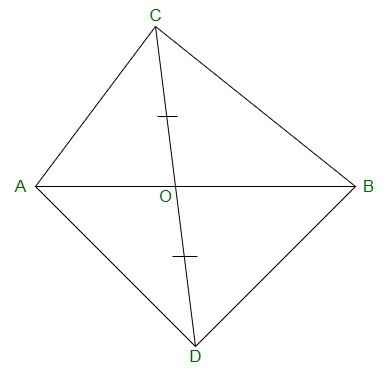
Solution:
In ΔABC, AO is the median. (CD is bisected by AB at O)
Therefore,
ar(AOC) = ar(AOD) -(equation 1)
also,
ΔBCD, BO is the median. (CD is bisected by AB at O)
Therefore,
ar(BOC) = ar(BOD) -(equation 2)
Adding equation (1) and (2),
We will get,
ar(AOC)+ar(BOC) = ar(AOD)+ar(BOD)
=> ar(ABC) = ar(ABD)
Question 5. D, E and F are respectively the mid-points of the sides BC, CA, and AB of a ΔABC. Show that
(i) BDEF is a parallelogram.
(ii) ar(DEF) = 1/4 ar(ABC)
(iii) ar (BDEF) = 1/2 ar(ABC)
Solution:
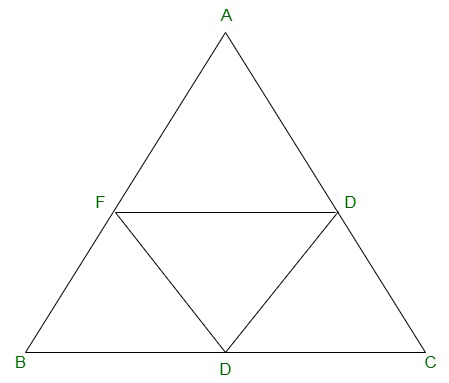
(i) In ΔABC,
EF || BC and EF = 1/2 BC (by mid point theorem)
also,
BD = 1/2 BC (D is the mid point)
So,
BD = EF
also,
BF and DE are parallel and equal to each other.
Therefore,
The pair opposite sides are equal in length and parallel to each other.
Hence, BDEF is a parallelogram.
(ii) Proceeding from the result of (i),
BDEF, DCEF, AFDE are parallelograms.
Diagonal of a parallelogram divides it into two triangles of equal area.
Therefore,
ar(ΔBFD) = ar(ΔDEF) (For parallelogram BDEF) -(equation 1)
also,
ar(ΔAFE) = ar(ΔDEF) (For parallelogram DCEF) -(equation 2)
ar(ΔCDE) = ar(ΔDEF) (For parallelogram AFDE) -(equation 3)
From equations (1), (2) and (3)
ar(ΔBFD) = ar(ΔAFE) = ar(ΔCDE) = ar(ΔDEF)
=> ar(ΔBFD) + ar(ΔAFE) + ar(ΔCDE) + ar(ΔDEF) = ar(ΔABC)
=> 4 ar(ΔDEF) = ar(ΔABC)
=> ar(DEF) = 1/4 ar(ABC)
(iii) Area (parallelogram BDEF) = ar(ΔDEF) + ar(ΔBDE)
=> ar(parallelogram BDEF) = ar(ΔDEF) + ar(ΔDEF)
=> ar(parallelogram BDEF) = 2× ar(ΔDEF)
=> ar(parallelogram BDEF) = 2× 1/4 ar(ΔABC)
=> ar(parallelogram BDEF) = 1/2 ar(ΔABC)
Question 6. In Figure, diagonals AC and BD of quadrilateral ABCD intersect at O such that OB = OD.

If AB = CD, then show that:
(i) ar (DOC) = ar (AOB)
(ii) ar (DCB) = ar (ACB)
(iii) DA || CB or ABCD is a parallelogram.
[Hint : From D and B, draw perpendiculars to AC.]
Solution:
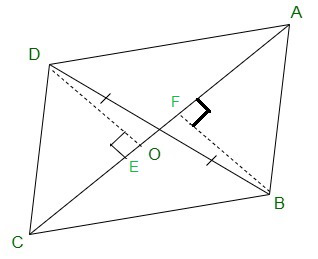
Given:
OB = OD and AB = CD
Construct,
DE ⊥ AC and BF ⊥ AC.
To proof:
(i) In ΔDOE and ΔBOF,
∠DEO = ∠BFO (Perpendiculars)
∠DOE = ∠BOF (Vertically opposite angles)
OD = OB (Given)
Therefore,
ΔDOE ≅ ΔBOF by AAS congruence condition.
Therefore, DE = BF (By CPCT) -(equation 1)
also,
ar(ΔDOE) = ar(ΔBOF) (Congruent triangles) -(equation 2)
Now,
In ΔDEC and ΔBFA,
∠DEC = ∠BFA (as they are perpendiculars)
CD = AB (Given)
DE = BF (From equation 1)
Therefore,
ΔDEC ≅ ΔBFA by RHS congruence condition.
Therefore,
ar(ΔDEC) = ar(ΔBFA) (Congruent triangles) -(equation 3)
Adding equation (2) and (3),
ar(ΔDOE) + ar(ΔDEC) = ar(ΔBOF) + ar(ΔBFA)
=> ar (DOC) = ar (AOB)
(ii) ar(ΔDOC) = ar(ΔAOB)
Adding ar(ΔOCB) in LHS and RHS,
we will get,
=> ar(ΔDOC) + ar(ΔOCB) = ar(ΔAOB) + ar(ΔOCB)
=> ar(ΔDCB) = ar(ΔACB)
(iii) When two triangles have same base and equal areas,
the triangles will be in between the same parallel lines
ar(ΔDCB) = ar(ΔACB)
DA || BC -(equation 4)
For quadrilateral ABCD, one pair of opposite sides are
equal (AB = CD) and other pair of opposite sides are parallel.
Therefore,
ABCD is parallelogram.
Question 7. D and E are points on sides AB and AC, respectively of ΔABC such that ar(DBC) = ar(EBC). Prove that DE || BC.
Solution:
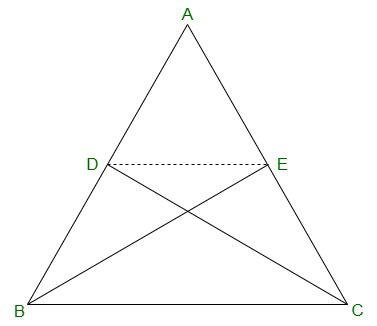
ΔDBC and ΔEBC are on the same base BC and are having equal areas.
Therefore,
They will lie between the same parallel lines.
Therefore,
DE || BC.
Question 8. XY is a line parallel to side BC of a triangle ABC. If BE || AC and CF || AB meet XY at E and F respectively, show that ar(ΔABE) = ar(ΔACF)
Solution:
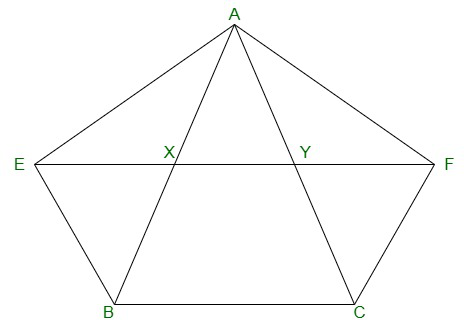
Given,
XY || BC, BE || AC and CF || AB
We have to show that,
ar(ΔABE) = ar(ΔAC)
Proof:
BCYE is a parallelogram as ΔABE and ||gm BCYE are on the same
base BE and between the same parallel lines BE and AC.
Therefore,
ar(ABE) = 1/2 ar(BCYE) -(equation 1)
Now,
CF || AB and XY || BC
=> CF || AB and XF || BC
=> BCFX is a parallelogram.
Thus ΔACF and parallelogram BCFX are on the same base CF
and in-between the same parallel AB and FC. Therefore,
ar (ΔACF)= 1/2 ar (BCFX) -(equation 2)
But,
Parallelogram BCFX and parallelogram BCYE are on the same
base BC and between the same parallels BC and EF. Therefore,
ar (BCFX) = ar(BCYE) -(equation 3)
From equations (1), (2) and (3),
We will get,
ar (ΔABE) = ar(ΔACF)
=> ar(BEYC) = ar(BXFC)
As the parallelograms are on the same base BC and
in-between the same parallels EF and BC -(equation 3)
Also,
ΔAEB and parallelogram BEYC are on the same base
BE and in-between the same parallels BE and AC.
=> ar(ΔAEB) = 1/2 ar(BEYC) -(equation 4)
Similarly,
ΔACF and parallelogram BXFC on the same base CF
and between the same parallels CF and AB.
=> ar(ΔACF) = 1/2 ar(BXFC) -(equation 5)
From equations (3), (4) and (5),
ar(ΔABE) = ar(ΔACF).
Question 9. The side AB of a parallelogram ABCD is produced to any point P. A line through A and parallel to CP meets CB produced at Q and then parallelogram PBQR is completed (see Figure). Show that
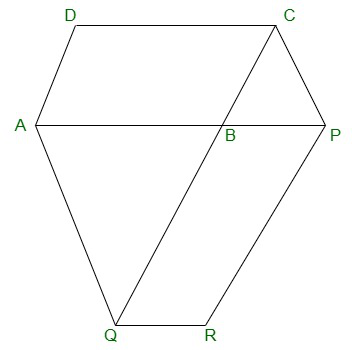
ar(ABCD) = ar(PBQR).
[Hint: Join AC and PQ. Now compare ar(ACQ) and ar(APQ).]
Solution:
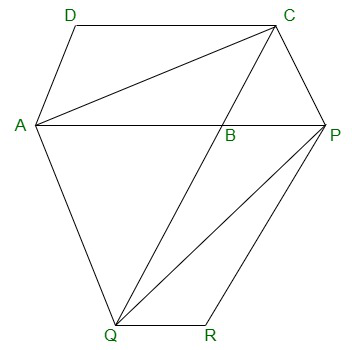
AC and PQ are joined.
Ar(ΔACQ) = ar(ΔAPQ)(On the same base AQ and between
the same parallel lines AQ and CP)
=> ar(ΔACQ)-ar(ΔABQ) = ar(ΔAPQ)-ar(ΔABQ)
=> ar(△ABC) = ar(△QBP) -(equation 1)
AC and QP are diagonals ABCD and PBQR.
Therefore,
ar(ABC) = 1/2ar(ABCD) -(equation 2)
ar(QBP) = 1/2 ar(PBQR) -(equation 3)
From equation (2) and (3),
1/2 ar(ABCD) = 1/2 ar(PBQR)
=> ar(ABCD) = ar(PBQR)
Question 10. Diagonals AC and BD of a trapezium ABCD with AB || DC intersect each other at O. Prove that ar (AOD) = ar (BOC).
Solution:
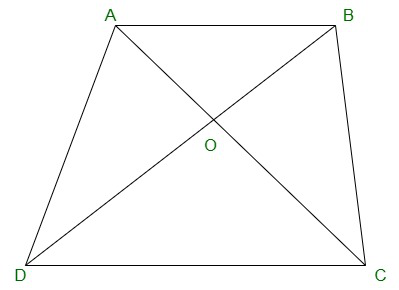
ΔDAC and ΔDBC lie on the same base DC and
between the same parallels AB and CD.
Ar(ΔDAC) = ar(ΔDBC)
=> ar(ΔDAC) – ar(ΔDOC) = ar(ΔDBC) – ar(ΔDOC)
=> ar(ΔAOD) = ar(ΔBOC)
Question 11. In Figure, ABCDE is a pentagon. A line through B parallel to AC meets DC produced at F.

Show that
(i) ar(ΔACB) = ar(ΔACF)
(ii) ar(AEDF) = ar(ABCDE)
Solution:
(i) ΔACB and ΔACF lie on the same base AC and between the same parallels AC and BF.
Therefore,
ar(ΔACB) = ar(ΔACF)
(ii) ar(ΔACB) = ar(ΔACF)
=> ar(ΔACB)+ar(ΔACDE) = ar(ΔACF)+ar(ΔACDE)
=> ar(ABCDE) = ar(AEDF)
Question 12. A villager Itwaari has a plot of land of the shape of a quadrilateral. The Gram Panchayat of the village decided to take over some portion of his plot from one of the corners to construct a Health Centre. Itwaari agrees to the above proposal with the condition that he should be given equal amount of land in lieu of his land adjoining his plot so as to form a triangular plot. Explain how this proposal will be implemented.
Solution:

Let us assume ABCD be the plot of the land of the shape of a quadrilateral.
Construction:
Join the diagonal BD.
Draw AE parallel to BD.
Join BE, that intersected AD at O.

We will get,
ΔBCE is the shape of Itwari’s original field
ΔAOB is the area for construction of the Health Centre.
ΔDEO is the land joined to the plot.
To prove:
ar(ΔDEO) = ar(ΔAOB)
Proof:
ΔDEB and ΔDAB lie on the same base BD, in-between the same parallels BD and AE.
Therefore,
Ar(ΔDEB) = ar(ΔDAB)
=> ar(ΔDEB) – ar(ΔDOB) = ar(ΔDAB) – ar(ΔDOB)
=> ar(ΔDEO) = ar(ΔAOB)
Question 13. ABCD is a trapezium with AB || DC. A line parallel to AC intersects AB at X and BC at Y. Prove that ar (ΔADX) = ar (ΔACY).
[Hint: Join CX.]
Solution:

Given:
ABCD is a trapezium with,
AB || DC.
XY || AC
To Construct,
Join CX
Prove:
ar(ADX) = ar(ACY)
Proof:
ar(ΔADX) = ar(ΔAXC) -(equation 1)(Since they are on the same base AX and
in-between the same parallels AB and CD)
also,
ar(ΔAXC)=ar(ΔACY) -(equation-2)(Since they are on the same base AC and
in-between the same parallels XY and AC)
From equation (1) and (2),
ar(ΔADX) = ar(ΔACY)
Question 14. In Figure AP || BQ || CR. Prove that ar(ΔAQC) = ar(ΔPBR).
Solution:

Given:
AP || BQ || CR
Prove:
ar(AQC) = ar(PBR)
Proof:
ar(ΔAQB) = ar(ΔPBQ) -(equation 1)(Since they are on the same base BQ and
between the same parallels AP and BQ)
also,
ar(ΔBQC) = ar(ΔBQR) (equation 2)(Since they are on the same base BQ and
between the same parallels BQ and CR)
Adding equations (1) and (2),
ar(ΔAQB)+ar(ΔBQC) = ar(ΔPBQ)+ar(ΔBQR)
=> ar(ΔAQC) = ar(ΔPBR)
Question 15. Diagonals AC and BD of a quadrilateral ABCD intersect at O in such a way that ar(△AOD) = ar(△BOC). Prove that ABCD is a trapezium.
Solution:

Given:
ar(ΔAOD) = ar(ΔBOC)
Prove:
ABCD is a trapezium.
Proof:
ar(ΔAOD) = ar(ΔBOC)
=> ar(ΔAOD) + ar(ΔAOB) = ar(ΔBOC)+ar(ΔAOB)
=> ar(ΔADB) = ar(ΔACB)
Areas of ΔADB and ΔACB are equal.
Therefore,
They should be lying between the same parallel lines.
Therefore,
AB ∥ CD
Hence, ABCD is a trapezium.
Question 16. In Figure, ar(DRC) = ar(DPC) and ar(BDP) = ar(ARC). Show that both the quadrilaterals ABCD and DCPR are trapeziums.

Solution:
Given:
ar(ΔDRC) = ar(ΔDPC)
ar(ΔBDP) = ar(ΔARC)
Prove:
ABCD and DCPR are trapeziums.
Proof:
ar(ΔBDP) = ar(ΔARC)
⇒ ar(ΔBDP) – ar(ΔDPC) = ar(ΔDRC)
⇒ ar(ΔBDC) = ar(ΔADC)
ar(ΔBDC) = ar(ΔADC).
Therefore,
ar(ΔBDC) and ar(ΔADC) are lying in-between the same parallel lines.
Hence, AB ∥ CD
ABCD is a trapezium.
Similarly,
ar(ΔDRC) = ar(ΔDPC).
Therefore,
ar(ΔDRC) and ar(ΔDPC) are lying in-between the same parallel lines.
Hence, DC ∥ PR
Thus, DCPR is a trapezium.
NCERT Solutions Class 9 Maths Chapter 9 Areas of Parallelograms and Triangles: Exercise 9.4
Question 1. Parallelogram ABCD and rectangle ABEF are on the same base AB and have equal areas. Show that the perimeter of the parallelogram is greater than that of the rectangle.
Solution:
Given: ||gm ABCD and rectangle ABEF lie on the same base AB.
ar(ABCD)=a(ABEF)
to prove: Perimeter of ||gm ABCD> perimeter of rectangle ABEF
AB+BC+CD+DA>AB+BE+EF+FA
Proof:
AB=CD —-[opposite sides of ||gm and rectangle are equal]
AB=EF —-[opposite sides of ||gm and rectangle are equal]
→CD=EF
Adding AB to both sides
CD+AB=EF+AB ———1
Here BC>BF ———[hypotenuse is always greater than other sides]
AD>AF ———[hypotenuse is always greater than other sides]
Adding them:
BC+AD>BE+AF —————2
Adding 1 and 2
CD+AB+BC+AD > EF+AB+BE+AF
BC+AD>BE+AF

Question 2. In Fig., D and E are two points on BC such that BD = DE = EC. Show that ar (ABD) = ar (ADE) = ar (AEC).
Solution:
Given: In ∆ABC,D and F are two points on BC such that BD=DE=EC
To prove:
Construction: Draw AM ⊥ BC
ar.(ABD)=1/2BD*AM ———1
ar.(ADE)=1/2*DE*AM
=1/2*BD*AM ——-2
Ar.(AEC)=1/2*EC*MA
=1/2*BD*AM ————3
From 1 ,2 and 3
ar.(ABD)=ar.(ADE)=ar.(AEC)

Question 3. In Figure, ABCD, DCFE and ABFE are parallelograms. Show that ar (ADE) = ar (BCF)
Solution:
Given: ||gm ABCD, DCFE, and ABFE
To prove: ar.(ADE)=ar.(BCF)
Proof: In ∆ADE and ∆BCF
AD = BC ——[opposite sides of ||gm ABCD]
DE = CF ——[opposite sides of ||gm DCFE]
AE = BF ——[opposite sides of ||gm ABFE]
∴∆ADE ≅ ∆BCF (S.S.S congruence)
→ar.(ADE) = ar.(BCF) ——-[congruent triangles have equal in area]

Question 4. In Fig., ABCD is a parallelogram and BC is produced to a point Q such that AD = CQ. If AQ intersects DC at P, show that ar (BPC) = ar (DPQ). [Hint: Join AC.]
Solution:
Given: In fig. ABCD is a ||gm AD=CQ
To prove: ar.(BPC)=ar.()
Construction: Join AC.
Proof: ACQD will be ||gm (∴AD=CQ, AD ||gm CQ)
In ∆APC and ∆QPD
AC=QD [opposite sides of ||gm]
∠ 3=∠ 4 [altitude interior angles]
∴∆APC≅∆QPD [A.S.A congruence]
→ar.(APC)=ar.(BPC) [because both lie on the same base PC and between same ||lines PC and AB]
From 1 and 2
ar.(BPC)=ar.(DPQ)

Question 5. In Fig., ABC and BDE are two equilateral triangles such that D is the mid-point of BC. If AE intersects BC at F, show that
(i) ar (BDE) = 14 ar (ABC)
(ii) ar (BDE) = 12 ar (BAE)
(iii) ar (ABC) = 2 ar (BEC)
(iv) ar (BFE) = ar (AFD)
(v) ar (BFE) = 2 ar (FED)
(vi) ar (FED) = 18 ar (AFC)
[Hint: Join EC and AD. Show that BE || AC and DE || AB, etc.]
Solution:
i) Given: ABC and BDE are equilateral triangles D is mid point of BC i.e. BD=DC
To prove:
Proof: Let AB=x=AC=BC
Then BD=x/2=BE=DE
ar.(ABC)=√3/4×2
ar.(BDE)=√3/4*(2/2)2
=√3/4*x2/4
=1/4*√3/4*x2
ar.(BDE)=1/4 ar.(ABC)

ii) to prove; ar.(BDE)=1/2 ar.(BAE)
Construction: Join EC
ED is median of ∆BFC
ar.(BDE)=1/2 ar.(BEC) ———–1
∠1=∠2=60° [altitude interior angles]
→BE||AC
AR.(BEC)=ar.(BEA) ————2[both lie on the same base BE and AC between same||lines BE and AC]
Taking 1
ar.(BDE)=1/2 ar.(BAE) [from 2]

iii) To prove: ar.(ABC)=2ar.(BEC)
From i
ar.(BDE)=1/4 ar.(ABC)
from ii
ar.(BDE)=1/2 ar.(BAE)
From I and ii
¼ ar(ABC)=1/2ar.(BAE)
Ar.(ABC)=1/24 ar.(BAE)
=2ar.(BAE)
Ar.(ABC)=2ar.(BFC) [ar.(BAE)=ar.(BEC) from ii]

iv) To show ar (BFE) = ar (AFD)
Construction: Join AD.
Proof: ∠3= ∠4=60° ——–[angles of equilateral triangles]
Also they are alternate interior angle
∴AE||ED
ar(EDB)=ar(EDA) ——-[both lie on the same base ED and Between same || lines ED and AB]
Subtracting ar(EDF) from both sides
ar(EDB)-ar(EDF)=ar.(EDA)-ar.(EDF)

v) To show :ar.(BFE)=2ar.(FED)
Solution: In ∆ADB
AD2=AB2+BD2
=x2-(x/2)2
=x2-(x2/4)
=3x2/4
AD=√3x2/4
=√3x/4
ar.(AFD)=1/2*ED*AD
=1/2*ED*(√3X)/2 ————-1
Construction: Draw EL⊥ BD
→angle is midpoint of BD
In ∆ELD
EL2=ED2-LD2
=(x/2)2-(x/4)2
=x2/4-x2/16
=4x2-x2/16
=3x2/16
EL=√3/10 X2
=√3/4 x
In ∆ADB
ar(FED)=1/2*FD*EL
=1/2*FD*√3/4 x
=1/2*FD*√3/xx *1/2
ar.(FED)=ar.(AFD)
2ar.(FED)=ar.(BFE) ——–[in part (iv) we prove ar(AFD=ar.(BFE)]

(vi) ar.(FED=1/8ar.(AFC))
Solution: ar(BDE)=1/4ar.(ABC)
ar.(BFE)+ar.(FED)=1/4ar.2*(ADC)
2ar.(FED)+ar(FED)=1/2ar.(AFC-1/2ar.(AFD))
3ar.(FED)=1/2ar.(AFC-AFD)
3ar.(FED)=1/2ar(AFC)-1/2ar.(AED)
3ar.(FED)=1/2ar.(AFC)-1/2 ar.*2(FED) ————[FROM (iv) and (v)]
3ar(FED)=1/2 ar.(AFC)-ar.(FED)
3ar.(FED)+ar.(FED)=1/2ar.(AFC)
4ar.(FED)=1/2ar.(AFC)
ar.(FED)=1/2*4 ar.(AFC)
ar.(FED)=1/8 ar.(AFC)

Question 6.Diagonals AC and BD of a quadrilateral ABCD intersect each other at P. Show that ar (APB) × ar (CPD) = ar (APD) × ar (BPC).[Hint :From A and C, draw ⊥s to BD.]
Solution:
Given: ABCD is quadrilateral. Diagonals AC and BD intersects at P.
To show: ar (APB) × ar (CPD) = ar (APD) × ar (BPC)
Construction: Draw AM ⊥BD &CN ⊥BD
L.H.S. ar.(APB)*(LPD)
½*PB*AM*1/2*DP*CN ————-1
¼*PB*AM*DP*LN
R.H.S. ar.(APD)*ar.(BPC)
½*DP*AM*1/2*BP*CN
¼*DP*AM*BP*CN
¼*PB*AM*DP*CN ————-2
From 1 and 2
L.H.S=R.H.S
∴ar.(APB)*ar.(CPD)=ar.(APD)*ar.(BPC)

Question 7. P and Q are respectively the mid-points of sides AB and BC of a triangle ABC and R is the mid-point of AP, show that
(i) ar (PRQ) = 12 ar (ARC)
(ii)ar (RQC) = 38 ar (ABC)
(iii) ar (PBQ) = ar (ARC)
Solution:
i) Given: In ∆ABC, P is midpoint of AB, Q is midpoint of BC, R is midpoint of AP
To show: ar (PRQ) = 12 ar (ARC)
Construction: Join AQ and PC
Solution : ar.(APQ) ———[∴QR is median of ∆APQ]
=½*1/2ar.(ABQ) ———[∴QP is median of ∆ABQ]
=1/2*1/2*1/2ar.(ABC) ———[∴AQ is median of ∆ABC]
=1/8ar.(ABC) ———-1
ar.(ARC)=1/2(APC) ——–[∴CR is median of ∆APC]
=1/2*1/2ar.(ABC) ———-[∴CP is median of ∆ABC]
=1/4ar.(ABC) ————2
Taking 1
ar.(PRQ)=1/8ar.(ABC)
=1/2*1/4ar.(ABC) ———-[from 2]

ii) ar.(RQC)=3/8ar.(ABC)
solution : ar(ABC)+ar.(ARQ)-ar(ARC) ——-1
ar(AQC)=1/2(ABC) [∴AQ is median of ∆ABC]
ar.(ABC)=1/2ar.(APQ) [∴QR is median of ∆APQ]
=1/2ar.(ABQ) [∴QP is median of ∆ABQ]
=1/2*1/2*1/2ar.(ABC) [∴AQ is median of ∆ABC]
=1/8ar.(ABC)
ar.(ARC)=1/2ar.(APC) [∴CR is median of ∆APC]
=1/2ar.(ABC) [∴CP is median of ∆ABC]
ar.(RQC)=ar.(AQC)+ar.(ARQ)+ar.(ARC)
=1/2ar.(ABC)+1/8ar.(ABC)-1/4ar.(ABC)
=(1/2+1/8-1/4)ar.(ABC)
=(4+1-2/8)ar.(ABC)
=(5-2/8)ar.(ABC)
=3/8ar.(ABC)

iii) To show: ar.(PBQ)=ar.(ARC)
ar(PBQ)=1/2ar.(ABQ) [∴∆ABQ , QP is median]
=1/2*1/2ar.(ABC) [∴∆ABC , AQ is median]
=1/4ar.(ABC) ———1
ar.(ARC)=1/2ar.(APC) [∴∆APC , CR is median]
=1/2*1/2ar.(ABC) [∴∆ABC , CP is median]
=1/4ar.(ABC) ——–2
Form I and 2
ar.(PBQ)=ar.(ARC)

Question 8. In Fig. 9.34, ABC is a right triangle right angled at A. BCED, ACFG and ABMN are squares on the sides BC, CA and AB respectively. Line segment AX⊥DE meets BC at Y.
Show that:
∆MBC ≅∆ABD
(ii)ar (BYXD) = 2 ar (MBC)
(iii) ar (BYXD) = ar (ABMN)(iv)∆FCB ≅∆ACE
(v) ar (CYXE) = 2 ar (FCB)
(vi)ar (CYXE) = ar (ACFG)
(vii) ar (BCED) = ar (ABMN) + ar (ACFG)
Note: Result (vii) is the famous Theorem of Pythagoras. You shall learn a simpler proof of this theorem in Class X.
Solution:
Given: ∆ABC, right angled at A. BCED,ACFG,ABMN are squares at Y.
i). to prove: ∆MBC ≅∆ABD
solution : In ∆MBC and ∆ABD
MB=AB [∴ABMN is an square ]
BC=BD [∴BCED is an square]
∠MBC=∠ABD [∠MBA=∠CBO=90°
∠MBA= +∠CBD+∠ABC
∴∠MBC=∠ABD]
∆MBC≅∆ABD [S.A.S congruency rule]

ii) To show: ar.(BYXD)=2ar.(MBC)
ar.(ABD)=1/2ar.(BYXD) [Both on the same base BD and between same || lines BD and AX]
ar.(MBC)=1/2ar.(BYXD) [in (i) ∆MBC≅∆ABD ∴ar.(MBC)=ar.(ABD) ]
2ar.(ABC)=ar.( BYXD)
ar.(MBC)=1/2ar.(ABMN)[ ∆MBC and ||gm ABMN both lie on the same base MB and between same || lines MB and NC.]
2ar.(MBC)=ar.(ABMN) ————–1
Also,
2ar.(MBC)=ar.(BYXD) [from ii] —————2
From 1 and 2
ar.(BYXD)-ar.(ABMN)

(iv) To show: ∆FCB≅∆ACE
In ∆FCB and ∆ACE
FC=AC [sides of square ACFG]
BC=CE [sides of square BCED]
∠FCB=∠ACE [∠ACE=∠BCE=90°
∠ACF+∠ACB=∠BCE+∠ACB
∴∠FCB=∠ACE]
∴∆FCB≅∆ACE [by S.A.S congruence ]

(v) To show : ar.(YXE)=2ar.(FCB)
ar.(ACE)=1/2ar.(CYXE) [∆ ACE and ||gm CYXE both lie on the same base CE and between same|| lines CE and AX]
ar. (FCB)=1/2(CYXE) [in (iv) ∆FCB≅∆ACE ∴ar.(FCB=ar.(ACE)]
2ar.(FCB)=ar.(CYXE)

(vi) To show : ar.(CYXE)=ar.(ACFG)[∆FCB and ||gm ACEFG both lie on the same base CF and BG Between CF and BG]
2 ar.(FCB)=ar.(ACFG) ———1
2ar.(FCB)=ar.(CYXE)
From 1 and 2
ar.(CYXE)=ar.(ACFG)
ar.(ABMN)+ar.(ACEFG)
ar.(BYXD)=ar.(ABMN) [form (iii)] ———1
ar.(CYXE)=ar.(ACFG) [From (iv)] ———–2
Adding 1 and 2
ar.(BYXD)+ar. (CYXE)=ar.(ABMN)+ar.(ACEFG)

(vii) ar.(ABMN)+ar.(ACEFG)
ar.(BYXD)=ar.(ABMN) [form (iii)] ———1
ar.(CYXE)=ar.(ACFG) [From (iv)] ———–2
adding 1 and 2
ar.(BYXD)+ar(CYXE)=ar.(ABMN)+ar.(ACEFG)
ar.(BCED)=ar.(ABMN)+ar.(ACFG)

Key Features of NCERT Solutions for Class 9 Maths Chapter 9 Areas of Parallelograms and Triangles
- NCERT Solutions are created for each chapter including Areas of Parallelograms and Triangles.
- These solutions provide in-depth solutions to the problems encountered by students in their NCERT textbook.
- These solutions are very accurate and comprehensive, which can help students prepare for any academic as well as competitive exam.
Also Check:
NCERT Solutions for Class 9 Maths Chapter 9 Areas of Parallelograms and Triangles– FAQs
1. Why is it important to learn about Class 9 Maths Chapter 9 Areas of Parallelograms and Triangles?
Learning about area is very important in many everyday situations. Whether you’re planning a room layout, figuring out how much paint to use, or deciding the size of a field for farming, it’s useful to understand how to calculate the area of parallelograms and triangles and NCERT Solutions for Class 9 Maths Chapter 9 Areas of Parallelograms and Triangles will help you with that.
2. What topics are covered in NCERT Class 9 Maths Chapter 9 Areas of Parallelograms and Triangles?
NCERT Class 9 Maths Chapter 9 Areas of Parallelograms and Triangles explains how to use a formula to compare the areas of various closed geometric shapes to find the areas of various closed shapes.
3. How can NCERT Solutions for Class 9 Maths Chapter 9 Areas of Parallelograms and Triangles help me?
NCERT Solutions for Class 9 Maths Chapter 9 Areas of Parallelograms and Triangles can help you solve the NCERT exercise without any limitations. If you are stuck on a problem, you can find its solution in these solutions and free yourself from the frustration of being stuck on some question.
4. How many exercises are there in NCERT Solutions for Class 9 Maths Chapter 9 Areas of Parallelograms and Triangles?
There are 4 exercises in the Class 9 Maths Chapter 9 – Areas of Parallelograms and Triangles which covers all the important topics and sub-topics.
5. Where can I find NCERT Solutions for Class 9 Maths Chapter 9 Areas of Parallelograms and Triangles?
You can find these NCERT Solutions for Class 9 Maths Chapter 9 Areas of Parallelograms and Triangles in this article created by our team of experts at GeeksforGeeks.
Share your thoughts in the comments
Please Login to comment...